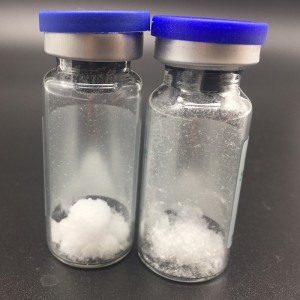Products
-

Tirzepatide
Tirzepatide is a novel dual agonist of GIP and GLP-1 receptors, developed for the treatment of type 2 diabetes and obesity. As a first-in-class “twincretin,” Tirzepatide enhances insulin secretion, suppresses glucagon release, and significantly reduces appetite and body weight. Our high-purity Tirzepatide API is chemically synthesized, free of host-cell-derived impurities, and meets international regulatory standards for quality, stability, and scalability.
-

Semaglutide
Semaglutide is a long-acting GLP-1 receptor agonist used for the treatment of type 2 diabetes and chronic weight management. Our high-purity Semaglutide API is produced through chemical synthesis, free from host cell proteins and DNA residues, ensuring excellent biosafety and consistent quality. Compliant with FDA guidelines, our product meets stringent impurity limits and supports large-scale production.
-

High Quality Weight Loss Peptide Retatrutide
Purity: >99%
Specification: 5mg/10mg/15mg/20mg/30mg
State: Lyophilized Powder
Transport Package: 10vials/Box
Appearance: White powder
-

High Purity Peptides Retatrutide 10mg for Weight Loss and Diabetes
Purity: >99%
State: Lyophilized Powder
Appearance: White powder
Specification: 5mg/10mg/15mg/20mg/30mg
-

Retatrutide
Retaglutide is a new dipeptidyl peptidase-4 (DPP-4) inhibitor class hypoglycemic drug that can prevent the degradation of glucagon-like peptide-1 (GLP-1) and glucose-dependent insulin-releasing polypeptide (GIP) by DPP-4 enzyme in the intestine and blood, prolonging their activity, thereby promoting insulin secretion by pancreatic β cells without affecting the basal level of fasting insulin, while reducing the secretion of glucagon by pancreatic α cells, thereby more effectively controlling postprandial blood sugar. It performs well in terms of hypoglycemic effect, tolerance, and compliance.
-

Inclisiran sodium
Inclisiran sodium API (Active Pharmaceutical Ingredient) is studied primarily in the field of RNA interference (RNAi) and cardiovascular therapeutics. As a double-stranded siRNA targeting the PCSK9 gene, it is used in preclinical and clinical research to evaluate long-acting gene-silencing strategies for lowering LDL-C (low-density lipoprotein cholesterol). It also serves as a model compound for investigating siRNA delivery systems, stability, and liver-targeted RNA therapeutics.
-

Fmoc-Gly-Gly-OH
Fmoc-Gly-Gly-OH is a dipeptide used as a basic building block in solid-phase peptide synthesis (SPPS). It features two glycine residues and an Fmoc-protected N-terminus, allowing for controlled peptide chain elongation. Due to glycine’s small size and flexibility, this dipeptide is often studied in the context of peptide backbone dynamics, linker design, and structural modeling in peptides and proteins.
-

Fmoc-Thr(tBu)-Phe-OH
Fmoc-Thr(tBu)-Phe-OH is a dipeptide building block commonly used in solid-phase peptide synthesis (SPPS). The Fmoc (9-fluorenylmethyloxycarbonyl) group protects the N-terminus, while the tBu (tert-butyl) group protects the hydroxyl side chain of threonine. This protected dipeptide is studied for its role in facilitating efficient peptide elongation, reducing racemization, and modeling specific sequence motifs in protein structure and interaction studies.
-

AEEA-AEEA
AEEA-AEEA is a hydrophilic, flexible spacer commonly used in peptide and drug conjugation research. It consists of two ethylene glycol-based units, making it useful for studying the effects of linker length and flexibility on molecular interactions, solubility, and biological activity. Researchers often use AEEA units to evaluate how spacers influence the performance of antibody-drug conjugates (ADCs), peptide-drug conjugates, and other bioconjugates.
-
![Fmoc-L-Lys[Eic(OtBu)-γ-Glu(OtBu)-AEEA]-OH](https://cdn.globalso.com/gentolexgroup/Glepaglutide10-300x300.png)
Fmoc-L-Lys[Eic(OtBu)-γ-Glu(OtBu)-AEEA]-OH
This compound is a protected, functionalized lysine derivative used in peptide synthesis and drug conjugate development. It features an Fmoc group for N-terminal protection, and a side-chain modification with Eic(OtBu) (eicosanoic acid derivative), γ-glutamic acid (γ-Glu), and AEEA (aminoethoxyethoxyacetate). These components are designed to study lipidation effects, spacer chemistry, and controlled drug release. It is widely researched in the context of prodrug strategies, ADC linkers, and membrane-interacting peptides.
-
![Fmoc-L-Lys[Ste(OtBu)-γ-Glu-(OtBu)-AEEA-AEEA]-OH](https://cdn.globalso.com/gentolexgroup/Glepaglutide9-300x300.png)
Fmoc-L-Lys[Ste(OtBu)-γ-Glu-(OtBu)-AEEA-AEEA]-OH
This compound is a modified lysine derivative used in peptide synthesis, particularly for constructing targeted or multifunctional peptide conjugates. The Fmoc group allows for stepwise synthesis via Fmoc solid-phase peptide synthesis (SPPS). The side chain is modified with a stearic acid derivative (Ste), γ-glutamic acid (γ-Glu), and two AEEA (aminoethoxyethoxyacetate) linkers, which provide hydrophobicity, charge properties, and flexible spacing. It is commonly studied for its role in drug delivery systems, including antibody-drug conjugates (ADCs) and cell-penetrating peptides.
-

Liraglutide Anti-Diabetics for Blood Sugar Control CAS NO.204656-20-2
Active Ingredient: Liraglutide (analog of human glucagon-like peptide-1 (GLP-1) produced by yeast through genetic recombination technology).
Chemical Name: Arg34Lys26-(N-ε-(γ-Glu(N-α-hexadecanoyl)))-GLP-1[7-37]
Other Ingredients: Disodium Hydrogen Phosphate Dihydrate, Propylene Glycol, Hydrochloric Acid and/or Sodium Hydroxide (as pH Adjusters Only), Phenol, and Water for Injection.

